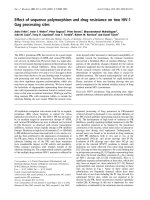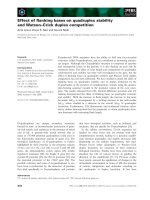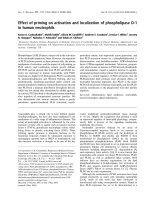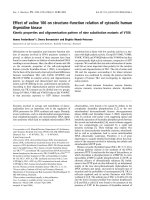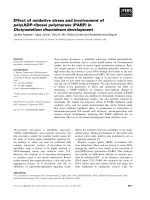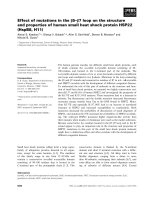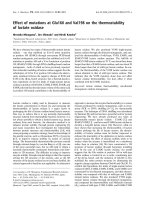Báo cáo khoa học: "Effect of endomycorrhizas and nematodes on the growth of seedlings of Dicorynia guianensis Amshoff, a tree species of the tropical rain forest in French Guiana " docx
Bạn đang xem bản rút gọn của tài liệu. Xem và tải ngay bản đầy đủ của tài liệu tại đây (436.85 KB, 7 trang )
Original
article
Effect
of
endomycorrhizas
and
nematodes
on
the
growth
of
seedlings
of
Dicorynia
guianensis
Amshoff,
a
tree
species
of
the
tropical
rain
forest
in
French
Guiana
M
Béreau
1
E
Louisanna
J
Garbaye
2
1
Station
de
recherches forestières,
Inra,
BP
709,
97387
Kourou;
2
Centre
de
recherches forestières
de
Nancy,
Inra,
54280
Champenoux,
France
(Received
30
November
1995;
accepted
17
July
1996)
Summary -
Seedlings
of
Dicorynia
guianensis
Amshoff,
an
economically
important
timber
tree
species
of
the
primary
tropical
rain
forest
of
French
Guiana,
were
grown
in
pots
containing
a
disin-
fected
soil
inoculated
or
not
with
forest
soil,
mycorrhizal
roots
of
D
guianensis
or
nematodes.
Plant
growth
parameters
and
root
endomycorrhizal
colonization
were
measured
after
200
days.
The
results
are
inconclusive
about
the
role
of
nematodes
but
clearly
show
that
D
guianensis
is
dependent
on
endomycorrhizal
symbiosis
for
its
development:
the
top
dry
weights
of
the
seedlings
inoculated
with
soil
or
roots
(with
87-84%
endomycorrhizal
roots)
are
77
and
54%
higher,
respectively,
than
that
of
the
uninoculated
seedlings
(with
no
mycorrhizas
observed).
In relation
with
previous
observations
in
the
forest,
these
results
support
the
hypothesis
that
endomycorrhizas
play
a major
role
in
the
regen-
eration
of
D
guianensis.
tropical
rain
forest
/ Dicorynia
guianensis
/
seedlings
/
endomycorrhizas
/
experimental
approach
Résumé -
Effet
des
endomycorhizes
et
des
nématodes
sur
la
croissance
des
semis
de
Dicorynia
guianensis
Amshoff,
une
essence
de
la
forêt
tropicale
humide
primaire
de
Guyane
française.
Des
semis
de
D
guianensis
ont
été
cultivés
en
pots
sur
un
sol
désinfecté
inoculé
ou
non
avec
un
sol
fores-
tier,
des
racines
mycorhizées
de
D
guianensis
ou
des
nématodes.
Des
paramètres
de
croissance
des
plantes
et
la
colonisation
endomycorhizienne
des
racines
ont
été
mesurés
au
bout
de
200
j. Les
résul-
tats
ne
sont
pas
concluants
en
ce
qui
concerne
le
rôle
des
nématodes,
mais
montrent
clairement
que
D
guianensis
est
dépendant
de
la
symbiose
endomycorhizienne
pour
son
développement :
les
poids
de
matière
sèche
des
parties
aériennes
des
semis
inoculés
avec
sol
ou
racines
(aux
racines
endomy-
*
Correspondence
and
reprints
Tel:
(594)
32
92
82;
fax: (594)
32
69
14
corhizées
à
87-84
%)
sont
respectivement
77
et
54
%
supérieurs
à
celui
des
semis
témoins
non
ino-
culés
(non
mycorhizés).
En
relation
avec
des
observations
antérieures
en
forêt,
ces
résultats
confor-
tent l’hypothèse
que
les
endomycorhizes
jouent
un
rôle
important
dans
la
régénération
de
D
guianensis.
forêt
tropicale
humide
/
Dicorynia
guianensis
/
semis
/
endomycorhizes
/
approche
expéri-
mentale
INTRODUCTION
Mycorrhizal
symbioses
play
a major
role
in
the
mineral
nutrition
of
plants
in
most
ter-
restrial
ecosystems.
However,
most
of
our
knowledge
on
the
dependency
of
plants
on
symbiotic
fungi
is
based
on
studies
in
tem-
perate
regions,
and
relatively
little
mycor-
rhizal
research
has
been
carried
out
in
neotropical
rain
forests
(Janos,
1980,
1984):
to
what
extent
do
mycorrhizas
play
a role
in
the
regeneration
of
the
forest
(survival
and
growth
of
tree
seedlings)?
Alexander
et
al
(1992),
discussing
the
role
of
mycor-
rhizas
in
the
regeneration
of
some
Malaysian
forests
trees,
suggest
that
mycorrhizas
are
obligate
for
the
establishment
of
tree
seedlings.
In
a
previous
work,
Béreau
and
Garbaye
(1994)
observed
that
endomycorrhizal
sym-
bioses
were
dominant
in
this
type
of
forest.
Root
galls
due
to
endoparasitic
nematodes
were
also
observed
on
two
Caesalpinioideae,
including
Dicorynia
guianensis
Amshoff
(local
names:
Angélique,
Basralocus,
Angel-
ica
do
Para,
Tapiuna),
an
economically
important
timber
species.
Thus,
the
aim
of
the
present
work
was
to
examine
experimentally
the
relationship
between
endomycorrhizas,
nematodes and
growth
of
D
guianensis
seedlings.
MATERIALS
AND
METHODS
The
experiment
was
set
up
according
to
a
fully
randomized
block
design,
with
four
treatments,
four
blocks
and ten
plants
within
each
block-
treatment
combination.
The
seeds
of
D
guianensis
were
extracted
from
pods
collected
on
the
forest
floor
at
the
experimental
site
of
Paracou
(Bariteau
and
Geof-
froy,
1989)
at
the
end
of
the
wet
season
(May-June
1994),
air-dried
and
kept
for
6
months
at
room
temperature.
They
were
treated
with
pure
sulfuric
acid
for
10
min
and
washed
five
times
with
sterile
distilled
water
in
order
to
break
their
dormancy.
They
were
then
surface-sterilized
with
a
0.1%
mercury
chloride
solution
(HgCl
2)
for
5
min
and
rinsed
four
times
with
sterile
water.
The
seeds
were
aseptically
germinated
on
sterile
filter
paper
humidified
with
distilled
water
and
used
after
root
emergence
(7
days).
A
ferrallitic
forest
soil
was
collected
at
the
experimental
site
of
Paracou,
sieved
through
a
1
cm
screen
and
steam-disinfected
at
90
°C
three
times
for
2
h
each,
with
1 day
intervals.
Table
1
gives
the
chemical
properties
of the
steamed
soil.
Two
weeks
later,
this
soil
was
filled
into 1.3
L
black
plastic
pots
according
to
the
following
four
treatments:
i)
Control
(disinfected
soil
without
any
addition).
ii)
Soil-inoculated
(disinfected
soil
mixed
with
30%
v/v
of
a
fresh
forest
soil
extracted
from
a
nearby
plot).
iii)
Root-inoculated
(disinfected
soil
plus
ca
10%
w/w
roots
of
D
guianensis).
The
roots
were
washed
with
6%
Ethoprophos
to
eliminate
the
nematodes,
abundantly
rinsed
with
tap
water,
cut
into
5-10
cm
pieces
and
thoroughly
mixed
with
the
disinfected
soil.
In
addition,
part
of
these
roots
were
blended
in
water
and
70
mL
of
the
suspension
was
added
on
top
of
each
pot.
iv)
Nematode-inoculated
(disinfected
soil
plus
90
mL
per
pot
of
nematode
suspension).
This
suspension
was
prepared
by
wet-sieving
30
kg
of
forest
soil
with
tap
water
through
a
125
μm
screen.
Nematode
galls
from
seedlings
of D guia-
nensis in
the
forest
were
crushed
in
a
mortar
and
added
to
the
suspension.
Live
nematodes
were
present
in
the
final
suspension
used
for
inocula-
tion.
Two
germinated
seeds
were
introduced
into
each
pot
but
only
one
plantlet
was
kept
after
2
weeks.
The
seedlings
were
grown
in
a
shade
tun-
nel
intercepting
85%
of
the
incident
light
(in
order
to
simulate
the
light
intensity
at
the
level
of
forest
floor
in
closed
stands)
in
Kourou
(on
the
coast
of
French
Guiana),
for
204
days.
The
tem-
perature
fluctuated
between
27
and
35
°C.
The
atmospheric
relative
humidity,
generally
higher
than
90%,
was
dependent
on
the
season
and
on
the
time
of
day.
The
pots
were
automatically
drip-watered
for
2
min
every
day
with
about
50
mL
tap
water
per
pot.
The
leaflets
were
counted
every
week
from
week
3
(Dicorynia
leaves
are
pinnate
composite).
From
week
14,
the
height
of
the
seedlings
(ter-
minal
bud
above
ground)
was
also
measured
weekly.
The
experiment
was
terminated
on
week
29;
at
that
time,
the
following
operations
were
per-
formed:
-
The
total leaf
area
per
plant
was
measured
with
a
portable
area
meter
(LI-COR
3000).
Leaves
and
stems
were
separately
oven-dried
at
80
°C
for
48
h
and
weighed.
-
The
root
systems
were
washed
free
of
soil
and
individually
rated
for
their
development
accord-
ing
to
a
scale
from
1
(the
smallest
root
systems)
to
3
(the
largest).
The
ten
root
systems
of
each
treatment
in
each
block
were
cut
into
4-5
cm
pieces
pooled
together
and
thoroughly
mixed.
A
random
subsample
was
cut into
1 cm
pieces, then
cleared
and
stained
(according
to
Kormanik
and
McGraw,
1982)
for
quantifying
endomycorrhizal
colonization
by
the
technique
of Trouvelot
et
al
(1986),
which
consists
in
evenly
spreading
root
segments
on
a
microscope
slide
and
observing
100
successive
fields.
Fields
containing
intra-
cellular
vesicles
and/or
hyphal
coils
were
recorded
as
being
colonized.
The
results
were
expressed
as
percent
of
fields
with
colonized
roots
and
transformed
by
arcsin
square
root
before
being
subjected
to
the
analysis
of
vari-
ance.
Arbuscules
were
not
found,
which
is
con-
sistent
with
field
observations
on
both
seedlings
and
mature
trees
of
D
guianensis
in
French
Guiana
(Béreau
and
Garbaye,
1994).
The
analysis
of
variance
of
the
data
was
first
performed
two-ways
(four
blocks
and
four
treat-
ments)
for
detecting
general
effects,
and
then
one-way
(four
treatments
and
40
replicates)
for
detecting
significant
differences
between
indi-
vidual
treatments
(except
for
mycorrhizal
colo-
nization
because
the
roots
of
the
ten
seedlings
were
pooled
in
each
block-treatment
combina-
tion).
RESULTS
The
results
concerning
growth
parameters
and
mycorrhizal
colonization
at
the
end
of
the
experiment
are
presented
in
figure
1.
The
two-way
analysis
of
variance
indicates
that
the
treatment
factor
was
statistically
significant
at
the
0.05
probability
level
for
all
parameters;
there
was
no
significant
block
effect.
The
size
of
the
root
systems
was
not
subjected
to
statistics;
however,
figure
1
shows
that
roots
were
more
developed
in
the
inoculated
treatments
than
in
the
con-
trol.
Mycorrhizal
colonization
was
high
in
the
soil-inoculated
and
root-inoculated
treat-
ments
(87
and
84%,
respectively),
low
in
the
nematode-inoculated
treatment
(19%)
and
absent
from
the
control.
Neither
nema-
tode
galls
nor
bacterial
nodules
were
observed
on
any
root
in
the
experiment.
(Field
survey
has
shown
that
D
guianensis
is
very
seldom
nodulated
in
French
Guiana;
Béreau
and
Garbaye,
1994.)
The
root
sys-
tems
were
smaller
in
the
control
than
in
the
inoculated
treatments,
but
roots
were
free
of
any
sign
of
pathogens
in
all
treatments.
Figure
1
shows
that
the
seedlings
in
both
the
soil-inoculated
(Si)
and
root-inoculated
(Ri)
treatments
had
greater
leaf
area,
more
leaflets,
greater
shoot
biomass
and
were
taller
than
those
in
the
control
treatment
(C);
they
also
had
greater
leaf
area
than
those
in
the
nematode-inoculated
(Ni)
treatment.
The
Si
treatment
increases
leaf
area
more
than
the
Ri
treatment.
The
curves
in
figure
2
show
leaflet
num-
ber
and
plant
height
against
time.
The
mean
number
of
leaflets
per
plant
was
higher
at
all
times
in
the
three
inoculated
treatments
than
in
the
control.
This
difference
increased
markedly
from
day
150
because
of
reduced
leaflet
formation
in
the
control.
The
differ-
ence
in
height
between
the
inoculation
treat-
ments
and
the
control
was
already
notable
before
day
90.
Later
on,
as
for the
number
of
leaflets,
the
height
increment
in
the
control
treatment
tended
to
slow
down
from
day
160.
There
was
no
significant
difference
between
treatments
for
the
leaf
weight
per
unit
of
surface
area.
DISCUSSION
As
shown
in
table
I,
the
chemical
proper-
ties
of
the
steamed
soil
used
as
a
growth
substrate
(A)
and
of
the
fresh
forest
soil
used
as
an
inoculum
(B)
only
markedly
differ
in
organic
carbon
content.
Because
only
30%
of
the
forest
soil
used
as
an
inoculum
was
added
to
the
steamed
soil
in
the
Si
treat-
ment,
we
may
consider
that
the
physico-
chemical
properties
of
the
substrate
were
not
significantly
modified.
This
is
supported
by
the
results
of
other
experiments
per-
formed
under
the
same
environmental
con-
ditions
(data
not
shown):
the
growth
of
seedlings
of
two
other
endomycorrhizal
species
of
Caesalpiniaceae
from
the
rain
forest
(Eperua
falcata
Aublet
and
Recor-
doxylon
speciosum
Benoist
Norm
and
Mar)
was
the
same
in
the
non-disinfected
soils
A
and
B.
Moreover,
the
similar
mycorrhizal
colonization
and
biomass
production
recorded
with
root
and
soil
inoculum
also
indicates
that
the
effect
of
the
Si
treatment
was
not
due
to
modifications
in
the
chemi-
cal
properties
of
the
substrate.
Concerning
soil
bacteria,
which
were
introduced
in
the
three
inoculated
treatments
but
not
in
the
control,
we
have
already
mentioned
that
D
guianensis
seedlings
had
no
bacterial
nod-
ules
neither
in
the
forest
nor
in
the
inocu-
lated
treatments
of
the
experiment.
There-
fore,
the
growth
difference
between
the
con-
trol
(non-mycorrhizal)
and
the
Si
treatment
(heavily
mycorrhizal
as
a
consequence
of
the
inoculation)
can
be
attributed
to
myc-
orrhizas.
The
conclusion
is
the
same
with
the
root
inoculum.
It
is
thus
established
that
seedlings
of
D
guianensis
are
dependent
on
endomycorrhizal
infection
for
optimal
growth
under
our
experimental
conditions.
When
considering
the
growth
kinetics
of
the
seedlings,
it
appears
that
mycorrhizal
inoculation
was
effective
as
early
as
20
days
for
leaflet
number
and
that
the
seedlings’
height
was
already
markedly
stimulated
at
90
days.
This
suggests
that
mycorrhizal
col-
onization
occurred
early
and
that
the
nutri-
ents
stored
in
the
seeds
were
rapidly
depleted
(mean
weight
of
a
dry
seed:
0.37
g).
In
addi-
tion,
the
slowing
down
of
the
growth
of
the
control
seedlings
from
day
160
suggests
that
they
were
less
able
than
mycorrhizal
seedlings
to
use
depleted
soil
nutrients
in
the
limited
volume
of
the
pots,
presumably
because
of
their
reduced
root
development.
Because
both
the
soil
and
the
endomyc-
orrhizal
inoculum
used
came
from
a
pri-
mary
forest
where
D
guianensis
is
native,
and
because
the
climate
conditions
of
the
experiment
were
as
close
as
possible
to
those
of
this
forest
at
ground
level,
we
may
also
assume
that
the
endomycorrhizal
structures
observed
in
the
pots
and
on
the
seedlings
sampled
in
the
forest
(Béreau
and
Garbaye,
1994)
are
the
same
and
that
D
guianensis
seedlings
are
as
mycorrhiza-dependant
in
the
forest
as
in
the
experiment.
This
strongly
supports
the
hypothesis
that
the
endomyc-
orrhizal
status
of
the
seedlings
is
a
critical
factor
controlling
the
regeneration
of D guia-
nensis
in
the
primary
tropical
rain
forest
of
French
Guiana.
The
treatments
inoculated
with
roots
(mainly
mycelium
and
vesicles
within
roots)
or
with
soil
(a
more
diversified
inoculum
with
spores,
mycelium
and
root
pieces)
have
the
same
level
of
endomycorrhizal
colo-
nization.
However,
the
Si
treatment
tends
to
result
in
a
better
growth
of
the
seedlings
(this
is
statistically
significant
for
leaf area
only,
but
the
same
trend
exists
for
leaflet
number
and
height
toward
the
end
of
the
experiment).
On
the
other
hand,
the
Ni
treat-
ment
stimulated
plant
growth
to
the
same
extent
as
the
two
mycorrhiza-inoculated
treatments,
in
spite
of
a
much
lower
myc-
orrhizal
colonization
of
the
roots;
this
may
be
due
to
the
125
μm
screen
which
elimi-
nated
root
fragments
and
large
spores
when
preparing
the
nematode
suspension,
thus
selecting
a
fraction
of
the
potential
sym-
bionts.
All
these
facts
suggest
that
the
fun-
gal
communities
were
not
the
same
in
the
different
treatments
and/or
that
the
inocu-
lum
type
influenced
the
colonization
rapid-
ity
and
the
efficacy
of
the
symbiosis.
According
to
Abbot
and
Gazey
(1994),
lit-
tle
is
known
about
the
impact
of
species
diversity
on
the
functioning
of endomycor-
rhizal
symbiosis.
Alexander
et
al
(1992)
observed
in
Malaysian
disturbed
forests
that
mycorrhizal
roots
and
hyphal
fragments
were
more
effective
natural
inocula
than
spores.
Therefore,
further
research
with
sin-
gle
spore
morphotype
inoculation
will
be
aimed
at
assessing
the
diversity
of
response
of
D
guianensis
to
the
endomycorrhizal
symbiosis.
The
experiment
was
inconclusive
as
far
as
nematodes
were
concerned:
inoculation
with
roots
of
D
guianensis
bearing
galls
and
living
Meloidogyne
sp
did
not
result
in
any
galls.
However,
the
duration
of
the
experi-
ment
might
have been
too
short
for
galls
to
develop
under
our
experimental
conditions.
It
is
known
that
galls
due
to
Meloidogyne
incognita
appear
on
tomato
roots
1 month
after
inoculating,
but
such
references
are
lacking
in
the
still
relatively
unexplored
field
of
tropical
tree
seedlings.
In
addition,
the
precise
age
of
the
D
guianensis
seedlings
in
the
forest,
on
which
galls
are
commonly
observed
(Béreau
and
Garbaye,
1994),
is
not
known.
AKNOWLEDGMENTS
The
authors
are
grateful
to
the
SILVOLAB
group
for
the authorization
to
collect
soil
and
roots
in
the
Paracou
experimental
forest,
A
Patient
for
his
technical
assistance,
T
Barigah
for
his
valu-
able
advice
in
setting
the
experiment
and
JM
Guehl
for
his
help
with
statistical
analyses.
We
also
thank
J
de
Merona
for
critical
reading
of
the
manuscript.
REFERENCES
Abbott
LK,
Gazey
C
(1994)
An
ecological
view
of the
formation
of VA
mycorrhizas.
Plant Soil
159,
69-78
Alexander
IJ,
Ahmad
N,
Susee
L
(1992)
The
role
of
mycorrhizas
in
the
regeneration
of some
Malaysian
forest
trees.
Phil
Trans
R Soc
Lond
[B] 335,
379-388
Bariteau
M,
Geoffroy
J
(1989)
Sylviculture
et
régénéra-
tion
naturelle
en
forêt
guyanaise.
Rev For
Fr
16,
309-323
Béreau
M,
Garbaye
J
(1994)
Tree
root
morphology
and
associated
organisms
in
the
primary
tropical
rain
forest
of French
Guiana.
Ann
Sci
For
51, 407-
416
Bremner JM
(1960)
Determination
of nitrogen
in
soil
by
the
Kjeldahl
method. J
Agric
Sci
55,
1-23
Janos
DP
(1980)
Vesicular-arbuscular
mycorrhizas
affect
lowland
tropical
rain
forest
plant
growth.
Ecology 61,
151-162
Janos
DP
(1984)
Methods
for
vesicular-arbuscular
mycorrhiza
research
in
the
lowland
wet
tropics.
In:
Physiological
Ecology
of
Plants
of the
Wet
Tropics
(E
Medina,
HA
Mooney,
C
Vazquez-Yanes,
eds),
Junk, the
Hague,
the
Netherlands,
173-187
Kormanik
PP,
McGraw
AC
(1982)
Quantification
of
vesicular
arbuscular
mycorrhizae
in
plant
roots.
In:
Methods
and
Principals
of Mycorrhizal
Research
(Schenk,
ed),
American
Pathological
Society,
37-45
Olsen
SR,
Cole
CU,
Watanabe
FS,
Dean
LA
(1954)
Estimation
of
available
phosphorus
in
soils
by
extinction
with
sodium
bicarbonate.
USDA
Circu-
lar 939,
19
Trouvelot
A,
Kough
JL,
Gianinazzi-Pearson
V
(1986)
Mesure
du
taux
de
mycorhization
VA
d’un
sys-
tème
radiculaire.
Recherche
de
méthodes
d’esti-
mation
ayant
une
signification
fonctionnelle.
In:
Mycorrhizae:
Physiology
and
Genetics.
Ist
ESM
Dijon,
France,
1-5
July
1985
(V
Gianinazzi-
Pearson,
S
Gianinazzi,
eds),
INRA,
Paris,
France,
217-221
Walkley
A,
Black
JA
(1934)
An
examination
of the
Degtjareff
method
for
determining
soil
organic
water
and
a
proposed
modification
of
the
chromic
acid
titration
method.
Soil
Sci
37, 29



